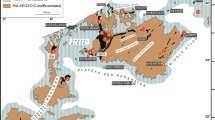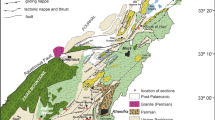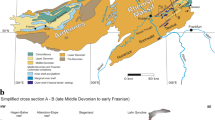Abstract
Tribes Hill domal thrombolites, termed here microbial reef mounds, occupied the basal part of meter-scale shallowing-upward cycles. They are part of a high-energy facies that a sharp, transgressive surface, separates from an underlying low-energy peritidal setting. This erosional surface served as the surface on which one of the reef mounds established itself during initial transgression before further deepening. The others overlie a floor of skeletal grainstone reflecting a high-stand sea-level facies tract. Skeletal grainstone composes the fill between the mounds. One channel and several aggrading hummocks occupy inter-reef mound areas resulting from storm events in a subtidal setting.
Similar content being viewed by others
References
AHR, W.M., 1971, Paleoenvironments Algal Structures, and Fossil Algae in the Upper Cambrian of Central Texas:Journal of Sedimentary Petrology, v. 41, p. 205–216.
AITKEN, J.D., 1967, Classification and Environmental Significance of Cryptalgal Limestones and Dolomites, With Illustrations From the Cambrian and Ordovician of Southwestern Alberta:Journal of Sedimentary Petrology, v. 37, p. 1163–1178.
BOSENCE, D.W.J. and BRIDGES, P.H., 1995, A Review of the Origin and Evolution of Carbonate Mud-Mounds. C.L.V. Monty, D.W.J. Bosence, P.H. Bridges, and B.R. Pratt, editors, Carbonate Mud-Mounds Their Origin and Evolution, International Association of Sedimentologists, Special Publication Number 23, p. 3–9.
BOVA, J.A. and READ, J.F., 1987, Incipiently Drowned Facies Within a Cyclic Peritidal Ramp Sequence, Early Ordovician Chepultepec Interval, Virginia Appalachians:Geological Society of America Bulletin, v. 98, p. 714–727.
BRAUN, M. and FRIEDMAN, G.M., 1969, Carbonate Lithofacies and Environments of the Tribes Hill Formation (Lower Ordovician) of the Mohawk Valley, New York:Journal of Sedimentary Petrology, v. 39, p. 113–188.
BROWNE, K.M. and DEMICCO, R.V., 1987, Thrombolites of the Lower Devonian Manlius Formation of Central New York:Carbonates and Evaporites, v. 2, p. 149–155.
BURNE, R.V. and MOORE, L.S., 1987, Microbialites: Organosedimentary Deposits of Benthic Microbial Communities:Palaios, v. 2, p. 241–254.
CAÑAS, FERNANDO and CARRERA, MARCELO, 1993, Early Ordovician Microbial-Sponge-Receptaculitid Bioherms of the Precordillera, Western Argentina:Facies, v. 29, p. 169–178.
CAÑAVERAS, J.C., SÁNCHEZ-MORAL, S., CALVO, J.P., HOYOS, M., and ORDÓÑEZ, S., 1996, Dedolomites Associated with Karstification. An Example of Early Dedolomitization in Lacustrine Sequences from the Tertiary Madrid Basin, Central Spain:Carbonates and Evaporites, v. 11, p. 85–103.
CHAFETZ, H.S. and BUCZYNSKI, CHRIS, 1992, Bacterially Induced Lithification of Microbial Mats:Palaios, v. 7, p. 277–293.
CHENGSHU, WANG, YUXU, ZHANG, LINZHI, GAO, et al., 1996, Field Trip Guide T 202: Sequence Stratigraphy of Cambro-Ordovician Carbonates in the Western Hills, Beijing. 30th International Geological Congress, Beijing, China.
CURL, M.W., ZAGORSKI, T.W., and FRIEDMAN, G.M., 1984, Depositional Environments and Diagenesis of Subsurface Tribes Hill Formation (Lower Ordovician), Mohawk Valley, New York:The Compass of Sigma Gamma Epsilon, v. 61, p. 216–243.
DE FREITAS, TIM and MAYR, ULRICH, 1995, Kilometer-Scale Microbial Buildups in a Rimmed Carbonate Platform Succession, Arctic Canada: New Insight on Lower Ordovician Reef Facies:Bulletin of Canadian Petroleum Geology, v. 43, p. 407–432.
DEMICCO, R.V., 1985, Platform and Off-platform Carbonates of the Upper Cambrian of Western Maryland, U.S.A.:Sedimentology, v. 32, p. 1–22.
DEMICCO, R.V. and HARDIE, L.A., 1994, Sedimentary Structures and Early Diagenetic Features of Shallow Marine Carbonate Deposits. SEPM (Society of Sedimentary Geology) Atlas Series No. 1, 265 p.
DYKSTRA, J.C.F. and LONGMAN, M.W., 1996, Gas Reservoir Potential of the Lower Ordovician Beekmantown Group, Quebec Lowlands, Canada: Reply:American Association of Petroleum Geologists Bulletin, v. 80.
EATON, AMOS, 1824, A Geological and Agricultural Survey of the District Adjoining the Erie Canal in the State of New York, Albany. 163 p.
ENDO, R., 1961, Phylogenetic Relationships Among the Calcareous Algae:Saitama University Science Report Ser. B Endo Commem., p. 1–48.
FISHER, D.W., 1954, Lower Ordovician Stratigraphy of the Mohawk Valley, N.Y.:Geological Society of America Bulletin, v. 65, p. 71–96.
FOLK, R.L., 1959, Practical Petrographic Classification of Limestones:American Association of Petroleum Geologists Bulletin, v. 43, p. 1–38.
FRIEDMAN, G.M., 1977, Carbonate and Terrigenious Sedimentary Facies of Tidal Origin, Eastern New Yorkin Guidebook to Field Excursions Conducted at the 49th Annual Meeting of the New York State Geological Association, Wilson, P.C., (ed.), NY State Geological Association, United States, p. 1–16.
FRIEDMAN, G.M., 1985a, The Problem of Submarine Cement in Classifying Reefrock: An Experience in Frustration:Carbonate Cements, Special Publication 36 Society of Economic Paleontologists Mineralogists, p. 117–121.
FRIEDMAN, G.M., 1985b, Cambro-Ordovician Shoaling and Tidal Deposits Marginal to Iapetus Ocean and Middle to Upper Devonian Peritidal Deposits of the Catskill Fan-Deltaic Complex. New York State Geological Association 57th Annual Meeting, Richard H. Lindemann, Editor, Skidmore College, Saratoga Springs, NY, p. 5–28.
FRIEDMAN, G.M., 1992, Significance of High-Frequency Stacking Patterns at the Cambro-Ordovician (Sauk) Passive Margin in the Albany-Basin Setting, New York (abstract):Northeastern Geology, v. 14, p. 68.
FRIEDMAN, G.M., 1993, High-Frequency Stacking Patterns at the Cambro-Lower Ordovician (Sauk) Passive Margin of the Western Atlantic (Iapetus) Ocean:Zentralblatt Geologie Paläontologie, v. 7/8, p. 797–808.
FRIEDMAN, G.M., 1994a, Stacking Patterns of Cyclic Parasequences in Cambro-Ordovician Carbonates of Eastern New York and Western Vermont:Northeastern Geology, v. 16, p. 145–157.
FRIEDMAN, G.M., 1994b, Upper Cambrian-Lower Ordovician (Sauk) Platform Carbonates of the Northern Appalachian (Gondwana) Passive Margin:Carbonates and Evaporites, v. 9, p. 143–150.
FRIEDMAN, G.M., 1994c, Recognition of Reefs in the Subsurface Rock Record: An Experience in Frustration. John T. Galey Memorial Address:Virginia Division of Mineral Resources, v. 132, p. 116–118.
FRIEDMAN, G.M., 1995, Cambro-Lower Ordovician (Sauk) Facies and Sequences: Case Histories From Eastern North America:in P.H. Pausé, and M.P. Candelaria, editors, Carbonate Facies and Sequence Stratigraphy: Practical Applications of Carbonate Models. Permian Basin Section-SEPM Publication 95-36 and Permian Basin Graduate Center Publication 5-95, p. 1–9.
FRIEDMAN, G.M., AMIEL, A.J., BRAUN, M. and MILLER, D.S., 1973, Generation of Carbonate Particles and Laminites in Algal Mats: Example From Sea-Marginal Hypersaline Pool, Gulf of Aqaba, Red Sea:American Association of Petroleum Geologists Bulletin, v. 57, p. 541–557.
FRIEDMAN, G.M., AMIEL, A.J., and SCHNEIDERMANN, N., 1974, Submarine Cementation in Reefs: Example From the Red Sea:Journal of Sedimentary Petrology, v. 44, p. 816–825.
FRIEDMAN, G.M. and SANDERS, J.E., 1967, Origin and Occurrence of Dolostones,in Chilingar, G.V., Bissell, H.J., and Fairbridge, R.W. (eds.) Carbonate Rocks, Origin, Occurrence, and Classification. p. 267–348, Amsterdam, Elsevier Publishing Company, 471 p.
FRIEDMAN, G.M., SANDERS, J.E., and KOPASKA-MERKEL, D.C., 1992, Principles of Sedimentary Deposits: Stratigraphy and Sedimentology. Macmillan, New York, 717 p.
FRIEDMAN, G.M., SANDERS, J.E., and MARTINI, I. PETER, 1982, Excursion 17A: Sedimentary Facies: Products of Sedimentary Environments in a Cross Section of the Classic Appalachian Mountains and Adjoining Appalachian Basin in New York and Ontario. Eleventh International Congress on Sedimentology, McMaster University, Hamilton, Ontario, Canada, variously paginated.
HARDIE, L.A., and SHINN, E.A., 1986, Carbonate Depositional Environments Modern and Ancient, Part 3: Tidal Flats:Colorado School of Mines Quarterly, v. 81, p. 1–74.
JAMES, N.P., 1981, Megablocks of Calcified Algae in the Cow Head Breccia, Western Newfoundland: Vestiges of a Cambro-Ordovician Platform Margin:Geological Society of America Bulletin, v. 92, p. 799–811.
JAMES, N.P. and BOURQUE, P.A., 1992, Reefs and Mounds.In: Facies Models. R.G. Walker and N.P. James (eds.). Geological Association of Canada, p. 229–257; 323–345.
JOHNSON, J.H., 1954, An Introduction to the Study of Rock-building Algae and Algal Limestones:Colorado School of Mines, v. Q49, 117 p.
KALKOWSKY, E., 1908, Oolith und Stromatolith im Norddeutschen Buntsandstein:Zeitschrift der Deutschen Geologischen Gesellschaft, v. 60, p. 68–125.
KELLER, MARTIN and FLÜGEL, ERIK, 1996, Early Ordovician Reefs From Argentina: Stromatoporoid vs Stromatolite Origin:Facies, v. 34, p. 177–192.
KENNARD, J.M. and JAMES, N.P., 1986, Thrombolites and Stromatolites: Two Distinct Types of Microbial Structures:Palaios, v. 1, p. 492–503.
KEUPP, H., JENISCH, A., HERRMANN, R., NEUWEILER, F. and REITNER, J., 1993, Microbial Carbonate Crusts: A Key to the Environmental Analysis of Fossil Spongiolites:Facies, v. 29, p. 41–54.
KOERSCHNER III, W.F. and READ, J.F., 1989, Field and Modeling Studies of Cambrian Carbonate Cycles, Virginia Appalachians:Journal of Sedimentary Petrology, v. 59, p. 654–687.
KRUMBEIN, W.E., 1983, Stromatolites-challenge of Term Through Space and Time:Precambrian Res., v. 20, p. 493–531.
LANDING, ED, WESTROP, S.R., and KNOX, L.A., 1996, Conodonts, Stratigraphy, and Relative Sea-Level Changes of the Tribes Hill Formation (Lower Ordovician, East-Central New York):Journal of Paleontology, v. 70, p. 656–680.
LEINFELDER, R.R., NOSE, M., SCHMID, D.U. and WERNER, W., 1993, Microbial Crusts of Late Jurassic: Composition, Paleoecological Significance, and Importance in Reef Construction:Facies, v. 29, p. 195–230.
MING, GE, XIANGHUA, MENG, and RONGKUN, CHEN, 1996, Bioherm Sequence and Sealevel Change Control. International Geological Correlation Programme (IGCP Project-319)in Sinian-Ordovician Paleogeography, Cyclicity-Rhythm and Sedimentary Events of China, Meng Xianghuna and Ge Meng, editors, International Academic Publishers, p. 147–155.
MONTY, C.L.V., 1995, The Rise and Nature of Carbonate Mud-Mounds: An Introductory Actualistic Approach, C.L.V. Monty, D.W.J. Bosence, P.H. Bridges, and B.R. Pratt, editors, Carbonate Mud-Mounds their Origin and Evolution, International Association of Sedimentologists, Special Publication Number 23, p. 11–48.
NADSON, G., 1903, Die Mikroorganismen als Geologische Faktoren. Petersburger Arb. Komm. Erf. Min Seen, Slavjansk, Petersburg.
OSLEGER, D.A. and MONTAÑEZ, I.P., 1996, Cross-platform Architecture of a Sequence Boundary in Mixed Siliciclastic-Carbonate Lithofacies, Middle Cambrian, Southern Great Basin, USA:Sedimentology, v. 43, p. 197–217.
PIA, J., 1927, Thallophyta.In: Hirmer M. (ed.) Handbuch der Palaeobotanik, Hirmer, Leipzig, v. 1, p. 1–136.
POHLER, S. and JAMES, N.P., 1989, Reconstruction of a Lower/Middle Ordovician Carbonate Shelf Margin: Cow Head Group, Western Newfoundland:Facies, v. 21, p. 189–262.
PRATT, B.R., 1989a, Continental Margin Reef Tract of Early Ordovician Age, Broken Skull Formation, Mackenzie Mountains, Northwest Canada.In: Reefs: Canada and Adjacent Areas. H.H.J. Geldsetzer, N.P. James and G.E. Tebbutt (eds.). Canadian Society of Petroleum Geologists, Memoir 13, p. 208–212.
PRATT, B.R., 1989b, Early Ordovician Cryptalgal-sponge Reefs, Survey Peak Formation, Rocky Mountains, Alberta. In: Reefs: Canada and Adjacent Areas. H.H.J. Geldsetzer, N.P. James and G.E. Tebbutt (eds.), Canadian Society of Petroleum Geologists, Memoir 13, p. 213–217.
PRATT, B.R. and JAMES, N.P., 1982, Cryptalgal-Metazoan Bioherms of Early Ordovician Age in the St. George Group, Western Newfoundland:Sedimentology, v. 29, p. 543–569.
READ, J.F., 1982, Geometry, Facies, and Development of Middle Ordovician Carbonate Buildups, Virginia Appalachians:American Association of Petroleum Geologists Bulletin, v. 66, p. 189–202.
READ, J.F. and GROVER, G.A., 1977, Scalloped and Planar Erosion Surfaces, Middle Ordovician Limestones, Virginia; Analogues of Holocene Exposed Karst or Tidal Rock Platforms:Journal of Sedimentary Petrology, v. 47, p. 956–972.
REITNER, J., 1993, Modern Cryptic Microbialite/Metazoan Facies From Lizard Island (Great Barrier Reef, Australia): Formation and Concepts:Facies, v. 29, p. 3–40.
RIDING, R., 1991, Classification of Microbial Carbonates.In: Calcareous Algae and Stromatolites. R. Riding (ed.) Springer-Verlag, Berlin, p. 21–51.
SLOSS, L.L., 1963, Sequence in the Cratonic Interior of North America:Geological Society of America Bulletin, v. 74, p. 93–114.
ULRICH, E.O., and CUSHING, H.P., 1910, Age and Relationship of the Little Falls Dolomite of the Mohawk Valley:New York State Museum Bulletin, v. 140, p. 97–140.
VAN WAGONER, J.C., 1985, Reservoir Facies Distribution as Controlled by Sea-level Changes: Society of Economic Paleontologists and Mineralogists Mid-Year Meeting, Abstract and Poster Session, Golden, Colorado, p. 91–92.
Author information
Authors and Affiliations
Rights and permissions
About this article
Cite this article
Friedman, G.M. Early ordovician microbial reef mounds of the tribes Hill formation, Mohawk Valley, New York. Carbonates Evaporites 11, 226–240 (1996). https://doi.org/10.1007/BF03175641
Received:
Accepted:
Published:
Issue Date:
DOI: https://doi.org/10.1007/BF03175641




